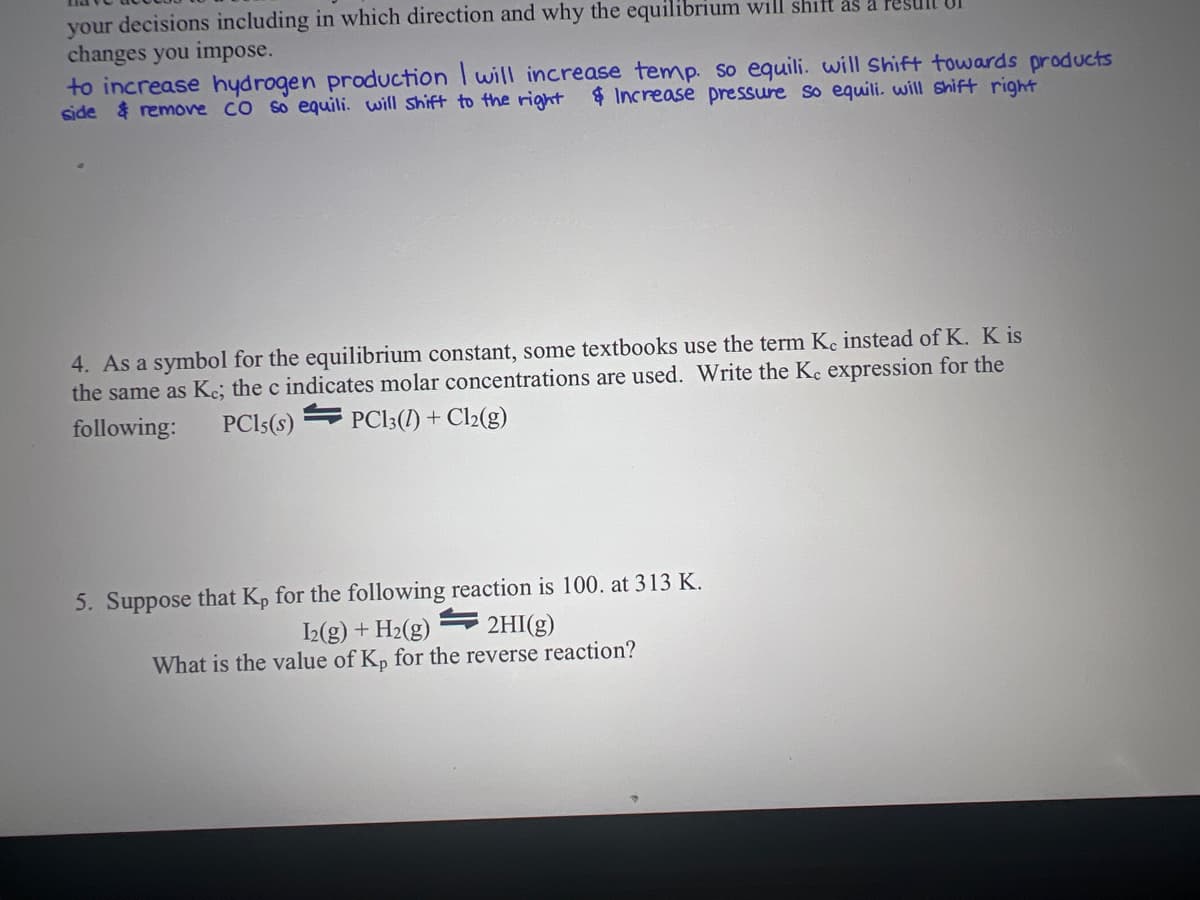4. As a symbol for the equilibrium constant, some textbooks use the term Ke instead of K. K is the same as Ke; the c indicates molar concentrations are used. Write the Ke expression for the following: PC15(s) PC13(1) + Cl₂(g) 5. Suppose that Kp for the following reaction is 100. at 313 K. I2(g) + H₂(g) 2HI(g) What is the value of Kp for the reverse reaction?
4. As a symbol for the equilibrium constant, some textbooks use the term Ke instead of K. K is the same as Ke; the c indicates molar concentrations are used. Write the Ke expression for the following: PC15(s) PC13(1) + Cl₂(g) 5. Suppose that Kp for the following reaction is 100. at 313 K. I2(g) + H₂(g) 2HI(g) What is the value of Kp for the reverse reaction?
Chemistry by OpenStax (2015-05-04)
1st Edition
ISBN:9781938168390
Author:Klaus Theopold, Richard H Langley, Paul Flowers, William R. Robinson, Mark Blaser
Publisher:Klaus Theopold, Richard H Langley, Paul Flowers, William R. Robinson, Mark Blaser
Chapter13: Fundamental Equilibrium Concepts
Section: Chapter Questions
Problem 73E: A student solved the following problem and found the equilibrium concentrations to be...
Related questions
Question
Help me solve questions 4 and 5

Transcribed Image Text:your decisions including in which direction and why the equilibrium will shift as a
changes you impose.
to increase hydrogen production I will increase temp. so equili. will shift towards products
side & remove CO so equili. will shift to the right & Increase pressure so equili. will shift right
4. As a symbol for the equilibrium constant, some textbooks use the term Ke instead of K. K is
the same as Ke; the c indicates molar concentrations are used. Write the Ke expression for the
following:
PC13 (1) + Cl2(g)
PC15(S)
5. Suppose that Kp for the following reaction is 100. at 313 K.
I2(g) + H₂(g)
2HI(g)
What is the value of Kp for the reverse reaction?
Expert Solution
This question has been solved!
Explore an expertly crafted, step-by-step solution for a thorough understanding of key concepts.
Step by step
Solved in 3 steps with 2 images

Knowledge Booster
Learn more about
Need a deep-dive on the concept behind this application? Look no further. Learn more about this topic, chemistry and related others by exploring similar questions and additional content below.Recommended textbooks for you

Chemistry by OpenStax (2015-05-04)
Chemistry
ISBN:
9781938168390
Author:
Klaus Theopold, Richard H Langley, Paul Flowers, William R. Robinson, Mark Blaser
Publisher:
OpenStax

Chemistry: Principles and Practice
Chemistry
ISBN:
9780534420123
Author:
Daniel L. Reger, Scott R. Goode, David W. Ball, Edward Mercer
Publisher:
Cengage Learning

Chemistry: Principles and Reactions
Chemistry
ISBN:
9781305079373
Author:
William L. Masterton, Cecile N. Hurley
Publisher:
Cengage Learning

Chemistry by OpenStax (2015-05-04)
Chemistry
ISBN:
9781938168390
Author:
Klaus Theopold, Richard H Langley, Paul Flowers, William R. Robinson, Mark Blaser
Publisher:
OpenStax

Chemistry: Principles and Practice
Chemistry
ISBN:
9780534420123
Author:
Daniel L. Reger, Scott R. Goode, David W. Ball, Edward Mercer
Publisher:
Cengage Learning

Chemistry: Principles and Reactions
Chemistry
ISBN:
9781305079373
Author:
William L. Masterton, Cecile N. Hurley
Publisher:
Cengage Learning

Chemistry: Matter and Change
Chemistry
ISBN:
9780078746376
Author:
Dinah Zike, Laurel Dingrando, Nicholas Hainen, Cheryl Wistrom
Publisher:
Glencoe/McGraw-Hill School Pub Co

Introduction to General, Organic and Biochemistry
Chemistry
ISBN:
9781285869759
Author:
Frederick A. Bettelheim, William H. Brown, Mary K. Campbell, Shawn O. Farrell, Omar Torres
Publisher:
Cengage Learning